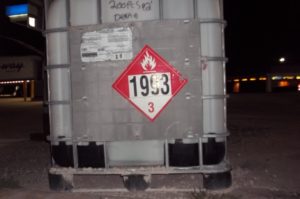Flash Point is a term used by the US EPA when characterizing an Ignitable Hazardous Waste and the US DOT when classifying a Flammable or Combustible Liquid. Though similar, there are differences in how these two Federal agencies define and describe this term. If you work with solvent, inks, paints, resins, fuels, or many other organic hydrocarbons it is necessary for you to be familiar with how both the US DOT and the US EPA identify this term and its role in identifying a hazardous material or a hazardous waste. The purpose of this article is to describe the use of the Flash Point for classifying a Flammable or Combustible Liquid per the regulations of the US DOT. You may also be interested in the US EPA’s use of Flash Point for the Determination of a Characteristic Ignitable Liquid Hazardous Waste.
The US DOT defines Flash Point at 49 CFR 173.120(c)(1): “Flash Point means the minimum temperature at which a liquid gives off vapor within a test vessel in sufficient concentration to form an ignitable mixture with air near the surface of the liquid.” It goes on to describe the methods to determine Flash Point based on the characteristics of the sample:
1. For a homogeneous, single-phase, liquid having a viscosity <45 S.U.S. at 38°C (100°F) that does not form a surface film while under test, one of the following test procedures shall be used:
- Standard Method of Test for Flash Point by Tag Closed Cup Tester, (ASTM D 56) (IBR; see §171.7 of this subchapter).
- Standard Test Methods for Flash Point of Liquids by Small Scale Closed-Cup Apparatus, (ASTM D 3278) (IBR; see §171.7 of this subchapter).
- Standard Test Methods for Flash Point by Small Scale Closed Tester, (ASTM D 3828) (IBR; see §171.7 of this subchapter).
2. For a liquid other than one meeting all the criteria of #1 above, one of the following test procedures must be used:
- Standard Test Methods for Flash Point by Pensky-Martens Closed Cup Tester, (ASTM D 93) (IBR; see §171.7 of this subchapter). For cutback asphalt, use Method B of ASTM D 93 or alternative tests authorized in this standard.
- Standard Test Methods for Flash Point of Liquids by Small Scale Closed-Cup Appartus (ASTM D 3279) (IBR; see §171.7 of this subchapter).
- Determination of Flash/No Flash – Closed Cup Equilibrium Method (ISO 1516) (IBR; see §171.7 of this subchapter).
- Determination of Flash Point – Closed Cup Equilibrium Method (ISO 1523) (IBR; see §171.7 of this subchapter).
- Determination of Flash Point – Pensky-Martens Closed Cup Method (ISO 2719) (IBR; see §171.7 of this subchapter).
- Determination of Flash Point – Rapid Equilibrium Closed Cup Method (ISO 3679) (IBR; see §171.7 of this subchapter).
- Determination of Flash/No Flash – Rapid Equilibrium Closed Cup Method (ISO 3680) (IBR; see §171.7 of this subchapter).
- Determination of Flash Point – Abel Closed-Cup Method (ISO 13736) (IBR; see §171.7 of this subchapter).
3. If the liquid is a mixture of compounds with different volatility and Flash Points (eg. mixed solvents and paint), its Flash Point must be determined by one of the methods in #’s 1 & 2 above on the material in the form in which it is to be shipped. Note that the form it is to be shipped in may differ from the form in which is was received as product or its form at its point of generation as a hazardous waste. If by this test the Flash Point is greater than -7°C (20°F), then a second test shall be made by the procedure described in §173.120(c)(2) which is too complicated for me to describe here.
4. And one final thing: for Flash Point determinations by Setaflash closed tester, the glass syringe specified need not be used as the method of measurement of the test sample if a minimum quantity of 2 mL (0.1 oz) is assured in the test cup.
These are just the regulations of the US DOT pertaining to the determination of one class of hazardous material: Flammable and Combustible Liquids. There are many more, and you must be familiar with all of them if you ship or receive hazardous materials in any quantity, including hazardous waste. My one day of training addresses the regulations of both the US DOT and the US EPA, it will help you to properly classify your hazardous materials and identify your hazardous waste. Contact me to schedule the right kind of training for you.

